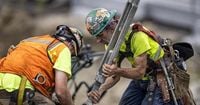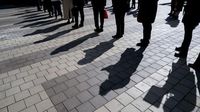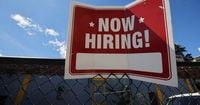The latest jobs report from the U.S. Department of Labor, released on September 5, 2025, has sent ripples through financial markets and reignited fierce debate in Washington over the direction of the American economy. With only 22,000 jobs added in August—dramatically missing economists’ expectations of 76,500—the data paints a sobering picture of a labor market losing steam under mounting economic and political pressures. The unemployment rate ticked up to 4.3%, its highest level since 2021, leaving 7.4 million Americans out of work and sparking concern among policymakers, businesses, and workers alike.
According to the Bureau of Labor Statistics (BLS), August’s meager job gains mark one of the weakest three-month streaks of employment growth since the Great Recession. For the first time in nearly four years, the economy actually lost jobs in June—shedding 13,000 positions after downward revisions. As Skanda Amarnath, executive director of Employ America and a former Federal Reserve economist, told Al Jazeera, “Another poor jobs report thanks to tariffs. With the benefit of revisions, it’s increasingly clear that tariffs are weighing on hiring and jobs. Manufacturing jobs are falling sharply, and so are other trade-sensitive sectors like mining and wholesale trade.”
The numbers tell a nuanced story. Healthcare and social assistance emerged as rare bright spots, adding 31,000 and 16,000 jobs respectively. Yet, these gains were offset by significant losses elsewhere: federal government jobs declined by 15,000, manufacturing shed 12,000, and oil and gas extraction dropped 6,000. Professional and business services, retail, construction, and leisure and hospitality saw only modest increases, underscoring the breadth of the slowdown. The private education and health services sector, which added 46,000 jobs in August, has become the main engine of job growth, but as Kory Kantenga, LinkedIn’s head of economics Americas, told CNN, “For 85% of workers, they’re not seeing a lot of the jobs added. If anything happens to that industry, you could easily see job growth fall off a cliff.”
One of the most troubling aspects of the report is the growing challenge for young Americans. The unemployment rate for those aged 16 to 24 climbed to 10.5% in August, the highest in nearly four years and more than double the national average. High school graduates aged 20 to 24 without college experience saw joblessness jump to 10.8%, up sharply from 8.8% in July. Even recent college graduates are struggling, with unemployment for those aged 20 to 24 with a bachelor’s degree or higher rising to 9.3%. Kevin Gordon, senior investment strategist at Charles Schwab, explained to CNN, “The ‘low hiring, low firing’ environment has disproportionately hit the younger cohort of new college grads. We’re now likely seeing the impact of AI on this cohort, especially as companies start turning to technology to save on costs.”
Black unemployment also rose to 7.5%, the highest in almost four years, highlighting persistent disparities. The labor force participation rate, after shrinking for three consecutive months, ticked up to 62.3% in August as 436,000 more people entered the job market. Yet, the increase in unemployment was largely attributed to these new job seekers struggling to find work, rather than layoffs alone.
Manufacturing, a centerpiece of President Donald Trump’s economic agenda, continues to falter. The industry lost jobs for the fourth straight month, totaling a loss of 78,000 positions so far in 2025. Matthew Martin, senior U.S. economist at Oxford Economics, described the sector as “paralyzed by uncertainty,” telling CNN that “the chaotic nature of trade policy to date is undermining efforts to reshore manufacturing jobs.”
Political fallout was swift. President Trump recently fired BLS Commissioner Erika McEntarfer, alleging—without evidence—that she manipulated the numbers for political purposes. Trump’s nominee to replace her, E.J. Antoni of the Heritage Foundation, has floated the idea of suspending monthly jobs reports in favor of quarterly releases to improve data accuracy, though he and White House officials have since stated that monthly reports will continue if he is confirmed. Angela Hanks of The Century Foundation criticized the firing, telling Al Jazeera, “This jobs report also affirms what we already knew—that President Trump’s firing of BLS Commissioner Erick McEntarfer was completely unwarranted and was definitionally a case of shooting the messenger.”
The weak jobs data has also intensified scrutiny of the Federal Reserve ahead of its September 16-17 policy meeting. Investors, rattled by the labor market’s deterioration, ramped up bets that the Fed will cut interest rates for the first time since December. Bank of America and other major financial institutions revised their forecasts, now expecting quarter-point cuts in both September and December. “The August jobs report is likely to amplify the Fed’s concerns about labor market weakness,” Aditya Bhave, senior U.S. economist at Bank of America, wrote in a note. Krishna Guha, vice chairman at Evercore ISI, echoed this, saying a September rate cut is now “locked.”
Markets reacted sharply. The Dow Jones Industrial Average fell as much as 400 points (0.88%) during Friday trading, while the S&P 500 and Nasdaq dropped 0.86% and 0.76% respectively. Treasury bonds and gold rallied as investors sought safe havens, and the U.S. dollar index sank 0.75%. Art Hogan, chief market strategist at B. Riley Wealth Management, summed up the mood: “Do we want the Fed to cut? Yes. But do we want the Fed to need to cut? No, that’s bad news for the economy and market.”
Within the White House, opinions diverged on the causes of the slowdown. National Economic Council Director Kevin Hassett conceded the jobs numbers were “a bit of a disappointment,” but expressed hope that revisions would show more robust growth. Hassett attributed weak job gains partly to changing immigration dynamics, stating, “All the job creation in the US has come from native-born workers, whereas in the Biden administration, it would be like maybe about half was foreign born.” However, data shows the foreign-born labor force has only declined slightly after peaking earlier this year, with some economists attributing the drop to survey response issues.
Commerce Secretary Howard Lutnick struck an optimistic note, predicting that tariffs would eventually incentivize manufacturing job growth and bring millions of sidelined Americans back into the workforce. “A year from today, you’re going to see employment numbers you’d never imagine,” Lutnick told CNBC. Labor Secretary Lori Chavez-DeRemer, meanwhile, blamed high interest rates for the slump, not tariffs, insisting, “Tariffs are working. How do I know this? Because companies are reinvesting in the American workforce. We’re seeing the consumer confidence up. We’re seeing real wages up year over year, almost 4% real wages are up.” Yet, BLS data shows real average hourly earnings rose just 1.2% over the past year through July, and nominal wage growth slowed to 3.7% in August.
As the nation digests the latest data, one thing is clear: the U.S. labor market is at a crossroads, with political, economic, and technological forces all shaping its uncertain path forward. The coming months—particularly the Federal Reserve’s decisions and the Senate’s confirmation of a new BLS commissioner—will be critical in determining whether the jobs engine can regain its lost momentum.


